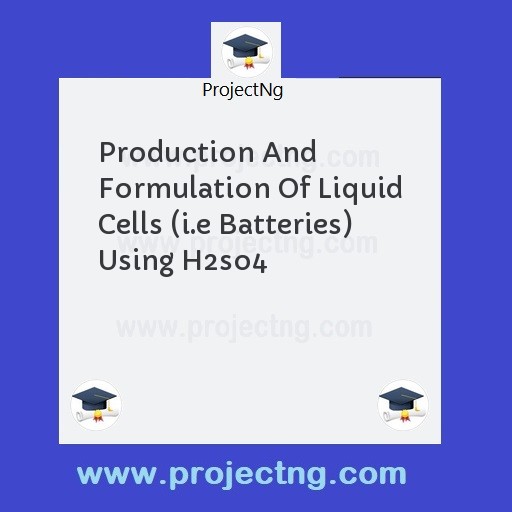Production And Formulation Of Liquid Cells (i.e Batteries) Using H2so4
Science Lab Technology Project Topics
Get the Complete Project Materials Now! »
PRODUCTION AND FORMULATION OF LIQUID CELLS (I.E BATTERIES) USING H2SO4
ABSTRACT
A 12v battery was produced with the lead oxide stripe, one of the electrode coated (positive electrode), while the other electrode, lead stripe is not coated (negative electrode). The electrolyte used for the formulation is dilute tetraoxosulphate (iv) acid (H2SO4). The lead oxide stripe is placed vertically inside a plastic casing and it is surrounded with insulators, also the lead stripe is placed vertically in the plastic casing and it is equally surrounded with insulators so that the two electrodes do not touch each other. The top of the plastic container containing the two electrode is sealed with adhesive gum and plastic so that it will be air tight. A small opening is created on the top of the plastic container where dilute sulphuric acid is introduced into the system. When a voltmeter is connected to the battery there is deflection of the pointer showing that potential difference is generated in the system.
TABLE OF CONTENTS
Title page i
Approval page ii
Dedication iii
Acknowledgement iv
Abstract v
Table of contents vi
CHAPTER ONE
1.0 INTRODUCTION 1
1.1 Background Of The Study 1
1.2 Statement of the Problem 3
1.3 Objectives of the Study 4
1.4 Significance of the Study 4
1.5 Scope of the Study 4
CHAPTER TWO
2.0 LITERATURE REVIEW 5
2.1 The Principle of Operation of Battery (Liquid Cell) 5
2.2 Types Of Battery 6
2.21 Primary Battery 7
2.22 Examples Of Primary Cells (Battery) 8
2.23 Types Of Secondary Cell 13
2.24 Charging And Discharging An Accumulator 15
2.3 Secondary Battery 17
2.4 Defects Of Battery 18
CHAPTER THREE
3.0 Materials And Method 20
3.1 Materials 20
3.2 Method 20
CHAPTER FOUR
4.0 Result 22
CHAPTER FIVE
5.0 Discussion, conclusion and recommendation 24
5.1 Discussion 24
5.2 Conclusion 25
5.3 Recommendation 25
References 26
CHAPTER ONE
6.0 INTRODUCTION
6.1 BACKGROUND OF THE STUDY
A battery is a device consisting of one or more electrochemical cells that converts stored chemical energy into electrical energy (Frank, 2001).
The first battery which is called voltaic pile was invented by Alessandro volta in 1800. After that the Daniel cell was discovered in 1836. Since the battery has become a common power source for many household and industrial applications. According to 2005 estimate, the worldwide battery industry generates 848 billions in sales each year, with 60% annual growth (John et al, 2005).
The usage of battery to describe electrical devices dates to Benjamin Franklin who in 1748 described multiple Leyder Jars (early electrical capacitors) by analogy to a battery of cannons. Thus Franklin usage to describe multiple leyder jars predicted volta’s use of multiple galvanic cells. It is speculated that several ancient artifacts consisting of copper sheets and iron bars and known as Beghded batteries may have been galvanic cells (Stinner, 2008).
Volta’s work was stimulated by the Italian anatomist and physiologist Luigi Galvani, who in 1780 noticed that dissected frog’s legs would twitch when struck by a spark from a leyden jar, an external source of electricity (Bellis, 2008). Although early batteries were of great value for experimented purposes, in practice their voltage fluctuates and they could not provide a large current for a sustained period of time later, starting with the Daniel cell in 1836, batteries provided more reliable currents and were adopted by industry for use in stationary devices, in particular in telegraph networks, where they were the only practical source of electricity, since electrical distribution networks did not exist at the time. These wet cells used liquid electrolyte which were prone to leakage and spillage if not handled correctly. Many used glass jars to hold their components, which made them fragile. These characteristics made wet cell unsuitable for portable appliances. Near the end of 19th century, the invention of dry cell batteries which replaced the liquid electrolyte with a paste made portable electrical devices practical. Since then batteries have gained popularity as they became portable and useful for a variety of purposes.
6.2 Statement of the Problem
Many electrical devices are powered by batteries even vehicles and that has necessitated a project work to be carried out on the production of battery (liquid cell).
6.3 Objectives of the Study
- To know the types of battery
- To know the material used in battery production
- To produce battery
6.4 Significance of the Study
This research work is meant to elucidate the materials used in battery production and also the method involved in producing liquid cell or battery.
6.5 Scope of the Study
Scope of this research work is limited to the production of liquid cell (battery) using sulphuric acid (H2SO4) as the electrolyte.
Be the First to Share On Social

Enjoying our content?
Don't miss out on new videos! Subscribe to our YouTube channel for more awesome content.
Subscribe Now!













